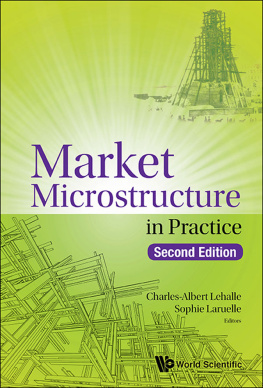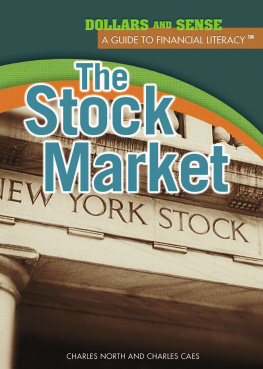Lehalle Charles-AlbertLaruelle Sophie - Market Microstructure In Practice (Second Edition)
Here you can read online Lehalle Charles-AlbertLaruelle Sophie - Market Microstructure In Practice (Second Edition) full text of the book (entire story) in english for free. Download pdf and epub, get meaning, cover and reviews about this ebook. year: 2018, publisher: World Scientific Publishing Company, genre: Business. Description of the work, (preface) as well as reviews are available. Best literature library LitArk.com created for fans of good reading and offers a wide selection of genres:
Romance novel
Science fiction
Adventure
Detective
Science
History
Home and family
Prose
Art
Politics
Computer
Non-fiction
Religion
Business
Children
Humor
Choose a favorite category and find really read worthwhile books. Enjoy immersion in the world of imagination, feel the emotions of the characters or learn something new for yourself, make an fascinating discovery.
- Book:Market Microstructure In Practice (Second Edition)
- Author:
- Publisher:World Scientific Publishing Company
- Genre:
- Year:2018
- Rating:4 / 5
- Favourites:Add to favourites
- Your mark:
- 80
- 1
- 2
- 3
- 4
- 5
Market Microstructure In Practice (Second Edition): summary, description and annotation
We offer to read an annotation, description, summary or preface (depends on what the author of the book "Market Microstructure In Practice (Second Edition)" wrote himself). If you haven't found the necessary information about the book — write in the comments, we will try to find it.
Market Microstructure In Practice (Second Edition) — read online for free the complete book (whole text) full work
Below is the text of the book, divided by pages. System saving the place of the last page read, allows you to conveniently read the book "Market Microstructure In Practice (Second Edition)" online for free, without having to search again every time where you left off. Put a bookmark, and you can go to the page where you finished reading at any time.
Font size:
Interval:
Bookmark:



Published by
World Scientific Publishing Co. Pte. Ltd.
5 Toh Tuck Link, Singapore 596224
USA office: 27 Warren Street, Suite 401-402, Hackensack, NJ 07601
UK office: 57 Shelton Street, Covent Garden, London WC2H 9HE
Library of Congress Cataloging-in-Publication Data
Names: Lehalle, Charles-Albert, editor. | Lamelle, Sophie, editor.
Title: Market microstructure in practice : 2nd edition / [edited by]
Charles-Albert Lehalle (Capital Fund Management, France & Imperial College London, UK),
Sophie Laruelle (Universit Paris-Est Crteil, France).
Description: Second Edition. | New Jersey : World Scientific, [2018] | Revised edition of
Market microstructure in practice, [2014] | Includes bibliographical references and index.
Identifiers: LCCN 2017045429 | ISBN 9789813231122
Subjects: LCSH: Capital market. | Finance. | Stock exchanges.
Classification: LCC HG4523 .M2678 2018 | DDC 332/.0415--dc23
LC record available at https://lccn.loc.gov/2017045429
British Library Cataloguing-in-Publication Data
A catalogue record for this book is available from the British Library.
Copyright 2018 by World Scientific Publishing Co. Pte. Ltd.
All rights reserved. This book, or parts thereof, may not be reproduced in any form or by any means, electronic or mechanical, including photocopying, recording or any information storage and retrieval system now known or to be invented, without written permission from the publisher.
For photocopying of material in this volume, please pay a copying fee through the Copyright Clearance Center, Inc., 222 Rosewood Drive, Danvers, MA 01923, USA. In this case permission to photocopy is not required from the publisher.
For any available supplementary material, please visit
http://www.worldscientific.com/worldscibooks/10.1142/10739#t=suppl
Desk Editor: Shreya Gopi
Typeset by Stallion Press
Email:
Printed in Singapore
Robert Almgren, President and Cofounder of Quantitative Brokers
Fragmentation, the search for liquidity, and high-frequency traders: These are the realities of modern markets. Traditional models of market microstructure have studied the highly simplified interaction between an idealized market-maker or specialist and a stream of external orders that may come from noise traders or informed traders. In the modern marketplace, the market itself is replaced by a loosely coupled network of visible and hidden venues, linked together by high-frequency traders and by algorithmic strategies. The distinction between market-makers who post liquidity and directional traders who take liquidity no longer exists. All traders are searching for liquidity, which may be flickering across many different locations with varying latencies, fill probabilities, and costs. That is the world this book addresses, treating these issues as central and fundamental rather than unwelcome complexities on top of a simple framework.
This market evolution is the farthest one in equity markets, thanks in large part to their size, social prominence as indicators of corporate value, and large variety of active traders from retail investors to sophisticated proprietary operations and large fundamental asset managers. Regulation has also been most active in equity markets, most importantly Reg NMS in the US and MiFiD in Europe. Other asset markets, such as foreign exchange, futures, and fixed income, are further back along this pathway, but it is clear that the direction of evolution is toward the landscape treated in this book rather than back to simpler times. Regulation will continue to shape further development of all these markets, and all market participants have an interest in increasing their as well as the regulators broad understanding of the underlying issues.
The central focus of the book is liquidity: Loosely speaking, the ease and efficiency with which large transactions can be performed. For any real user of the market, this is the primary concern, although academic researchers may focus on other aspects. Thus, fragmentation and high-frequency trading are addressed from this point of view. Throughout the book, the emphasis is on features of the marketplace that are of tangible and pressing concern to traders, investors, and regulators.
The authors have extensive personal experience of the development of the European equity markets as traders and as participants in conversations with regulators and other interested parties. They bring this experience to bear on every aspect of the discussion as well as deep quantitative understanding. The resulting book is a unique mixture of real market knowledge and theoretical explanation. There is nothing else out there like it, and this book will be a central resource for many different market participants.
Bertrand Patillet, Deputy Chief Executive Officer of CA Cheuvreux until April 2013
MiFID I removed the freedom of national regulators to maintain the secular obligation to concentrate orders on historical markets. In this way, the regulation, without a doubt, lifted the last regulatory obstacle preventing Europe from experiencing for better or for worse perhaps the macro and microstructural changes already at work on North American markets. This complete shift in paradigm was to render obsolete our savoir-faire and knowledge of how equity markets work.
We needed to observe, analyse, understand, and, to a certain extent, anticipate and foresee the consequences of the transformations underway that would drastically change the structure of inter and intramarket liquidity and thus the nature of the information conveyed by order books, the right reading of which is vital to obtaining the best price for our clients. Only then could we redefine our approach to best execution and adapt our behaviour and our tools.
We could not have achieved this task without resources, hitherto the monopoly of certain hedge funds or derivatives desks, but unknown to agency brokers, namely, profiles capable of extracting useful information from market data in order to better model new behaviours, validate or invalidate intuitions and ultimately provide our traders with buy or sell decision-making tools in these exceedingly complex markets. This is why, as early as 2006, we decided to form a team of quantitative analysts with strong links to the academic world, and headed by Charles-Albert, newly hired at Crdit Agricole Cheuvreux. This move was to transform our execution practices beyond our expectations and place us among the leaders.
Before MiFID II imposes new rules for structuring financial markets, this book provides a point of view, far from the preconceived ideas and pro domo pleas of such and such a lobby, on market microstructure issues the subject of impassioned, fascinating, and as yet unclosed debate which will interest all those who, in one respect or another, are concerned with improving how equity markets work.
Philippe Guillot, Executive Director, Markets Directorate, Autorit des marchs financiers (AMF)
When Charles-Albert asked me to write a foreword for his book on market microstructure, in which many of the topics are reminiscent of the uncounted hours spent discussing them while we were at Cheuvreux, he specifically asked for one (alas, only one) of the many analogies I use to help people getting a grasp on microstructure. A good proportion comes from comparing the electronics markets to aviation, with a big difference worth noting: At the beginning of aviation, as Igor Sikorsky said, the chief engineer was almost always the chief test pilot, which had the fortunate result of eliminating poor engineering at an early stage in aviation (could we do something similar for algos?). When comparing the two today, what is probably missed the most in the market microstructure is common sense.
Font size:
Interval:
Bookmark:
Similar books «Market Microstructure In Practice (Second Edition)»
Look at similar books to Market Microstructure In Practice (Second Edition). We have selected literature similar in name and meaning in the hope of providing readers with more options to find new, interesting, not yet read works.
Discussion, reviews of the book Market Microstructure In Practice (Second Edition) and just readers' own opinions. Leave your comments, write what you think about the work, its meaning or the main characters. Specify what exactly you liked and what you didn't like, and why you think so.













